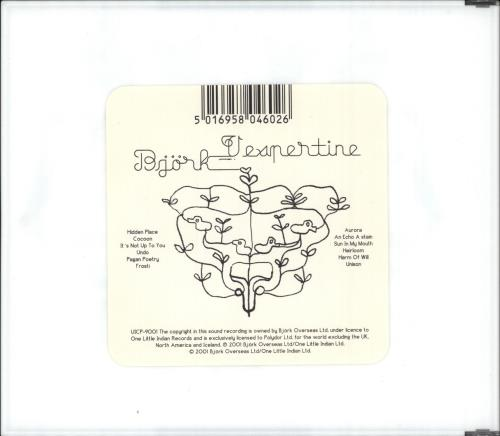
Icelandic Björk began her music career at the age of 11 and became an international star with the Sugarcubes and their hit from 1987 titled "Birthday". After the breakup of that band she started her solo career in 1992.
In 2001 she released her fourth album titled "Vespertine". She started recording the album while she was acting in Lars von Trier's musical "Dancer In The Dark" that was released in 2000 in the cinemas. The album reached #20 in the Netherlands, #19 in the US and #8 in the UK. There has been a big gap between her last album "Homogenic" which dates from 1997. The tension of filming the "Dancer In The Dark" movie also made her decide to start recording again. The working title for the album was "Domestika". It sounds very introverted and computerized.
Three singles were released from the album: "Hidden Place", "Pagan Poetry", and "Cocoon".
 |
| Album artwork |
Vespertine's sound reflected Björk's newly found interest in the music
of artists like Opiate (Thomas Knak) and Console who were also enlisted as producers. It has a very intimate and domestic sound. Assisted by the duo Matmos she created "microbeats" from various household sounds, such as that of shuffling cards and ice being cracked for example. She transformed the instrumental song "Crabcraft" by electronic musician Console into "Heirloom". The themes on the album are about sex and love inspired by her at the time new relationship with Matthew Barney. She uses the harpist Zeena Parkins, an inuit choir form Greenland and strings on the album. Björk decided also to use instruments whose sound would not be compromised when downloaded from websites like a harp, music box, celeste and clavichord. Originally it was intended to sound like everyday life and therefore titled "Domestika" but the title was soon changed to "Vespertine" suggesting a creation of magic through much more powerful forces!
Simply put, Björk is nothing less than a sonic genius and "Vespertine" is nothing short of brilliance.
 |
| Painting of Leda and the swan by Leonardo da Vinci |
The album cover refers to the mythic figure of Leda, but more particularly the familiar legend in which she exchanges her husband, the Spartan king Tyndareus, for the God Zeus when he approaches her in disguised form. The album cover was made by Inez van Lamsweerde and Vinoodh Matadin in Los Angeles, California.
 |
| Backside of the original CD |
 |
| Original album cover with sticker |
Vespertine (2001)
Hidden Place / Cocoon / It's Not Up To You / Undo / Pagan Poetry / Frosti / Aurora / An Echo, A Stain / Sun In My Mouth / Heirloom / Harm Of Will / Unison
It's Not Up To You
Hidden Place



0 Comments
Please feel free to leave any comments below!